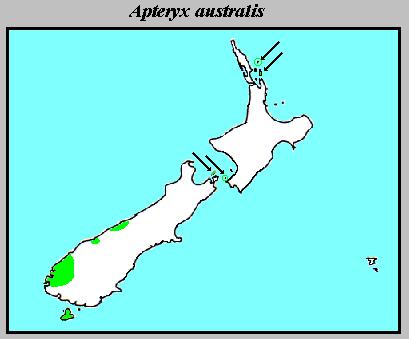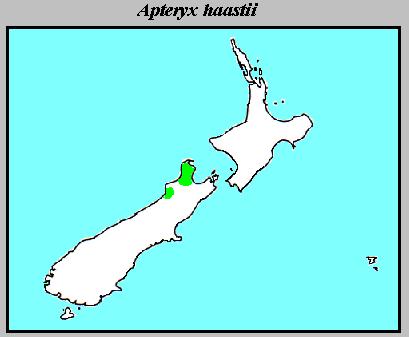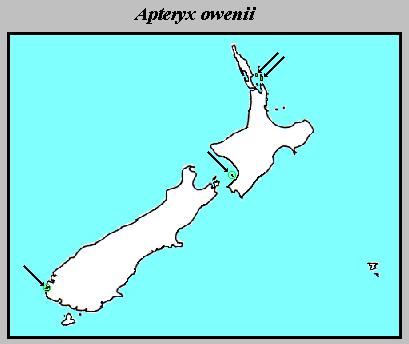New Zealand Kiwi Bird
Home > New Zealand Information > Kiwi Information
Kiwi
From Wikipedia, the free encyclopaedia
| Kiwi
Conservation status: Vulnerable |
||||||||||||
|---|---|---|---|---|---|---|---|---|---|---|---|---|
|
Apterygidae apteryx |
||||||||||||
| Scientific classification | ||||||||||||
|
||||||||||||
| Species | ||||||||||||
|
A. australis |
A kiwi is any of the species of small flightless birds native to New Zealand of the genus Apteryx (the only genus in family Apterygidae). At around the size of a domestic chicken, kiwi are by far the smallest living ratites. Though they are thought to be most closely related to either cassowaries or moa, their evolutionary origin is still uncertain. Several kiwi species are endangered.
Prior to the arrival of humans in about 1300, New Zealand's only endemic mammals were two species of bat (the long-tailed bat (Chalinolobus) and the short-tailed bat (Mystacina)). The ecological niches that in other parts of the world were filled by creatures as diverse as horses, wolves and mice were taken up by birds (and, to a lesser extent, reptiles).
Kiwi are shy, nocturnal creatures with a highly developed sense of smell and, most unusual in a bird, nostrils at the end of their long, sharp bill. They feed by thrusting the bill into the ground in search of worms, insects, and other invertebrates; though they also take fruit and, if the opportunity arises, small crayfish, amphibians and eels.
Their adaptation to a terrestrial life is extensive: like all ratites they have no keel on the breastbone to anchor wing muscles, and barely any wings either: the vestiges are so small that they are invisible under the kiwi's bristly, hair-like, two-branched feathers. While birds generally have hollow bones to save weight and make flight practicable, kiwi have marrow, in the style of mammals. With no constraints on weight from flight requirements, some Brown Kiwi females carry and lay a single 450 gram egg.
Currently there are three accepted species, one of which has two sub-species:
- The North Island Brown Kiwi, Apteryx australis mantelli is widespread in the northern two-thirds of the North Island and with about 35,000 remaining is the most common kiwi. Females stand about 400 mm high and weigh about 2.8 kg, the males about 2.2 kg. The North Island Brown has demonstrated a remarkable resilience: it adapts to a wide range of habitats, even non-native forests and some farmland. The plumage is streaky red-brown and spiky. The female usually lays two eggs, which are incubated by the male.
- The Okarito Brown Kiwi, Apteryx australis australis, is a recently identified sub-species of the North Island Brown, slightly smaller, with a greyish tinge to the plumage and sometimes white facial feathers. Females lay as many as three eggs in a season, each one in a different nest. Male and female both incubate. These Kiwi are distributed in the South Island of New Zealand.
Analysis of mitochondrial DNA, ecology, behaviour, morphology, geographic distribution and parasites of the North Island Brown Kiwi has led scientists to propose that the North Island Brown Kiwi is three distinct species. The North Island Brown Kiwi, the Okarito Brown Kiwi, or Rowi, whose distribution is restricted to a single site on the West Coast of the South Island of New Zealand. A third distinct population of the North Island Brown Kiwi is the Tokoeka, distributed in the in lowland forest to the north of Franz Josef glacier in the South Island. Reclassification would make five recognised kiwi species.
- The largest species is the Great Spotted Kiwi, Apteryx haastii, which stands about 450 mm high and weighs about 3.3 kg. (Males about 2.4 kg) It has grey-brown plumage with lighter bands. The female lays just one egg, with both sexes incubating. Population is estimated to be over 20,000, distributed through the more mountainous parts of northwest Nelson, the northern West Coast, and the Southern Alps.
- The very small Little Spotted Kiwi, Apteryx owenii is unable to survive predation by imported pigs, stoats and cats and is extinct on the mainland and the most threatened of all kiwi. About 1000 remain on Kapiti Island and it has been introduced to other predator-free islands and appears to be becoming established. A docile bird the size of a bantam, it stands 250 mm high and the female weighs 1.3 kg. She lays one egg which is incubated by the male.
Distribution of Kiwi Birds in New Zealand
 |
 |
 |



